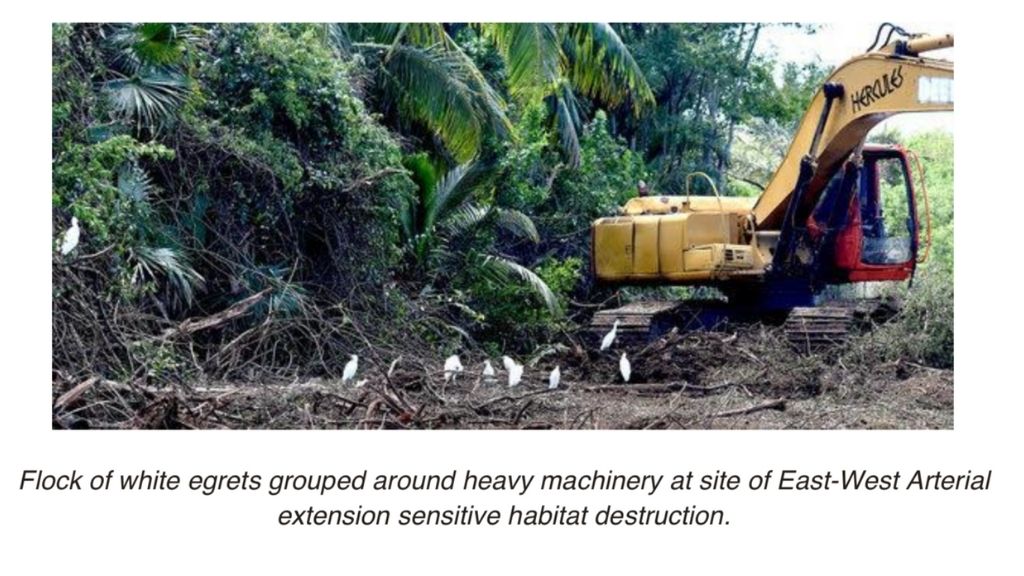by Kayla Young
As a rash of roads and luxury building projects push forward in the lead up to the April 14 elections, The Cayman Islands Mangrove Rangers have begun reaching out to the construction sector, including Dart, to invite discussion on environmentally conscious development.
With the Plan Cayman development scheme underway, Grand Cayman faces extensive loss of its already devastated wetlands.
The same roads and building projects that buoy the pandemic-stricken economy come with long-term environmental threats when planning regulations and best practices are not enforced.
Between 1976 and 2018, 72 per cent of the mangrove habitat in western Grand Cayman, spanning from Savannah to West Bay, had already been lost, according to data shared by the Department of Environment. That’s 3,845 acres of natural hurricane protection and native habitat gone, and the number grows by the day.
As part of government’s development plans, more than $30 million worth of roads projects have been given the green light. Much of the two-mile expansion of the East-West Arterial had already been cleared on 6 March when rangers Dinara Perera and Kayla Young visited the site.
Infrastructure Minister Joey Hew, in March 5 comments to the local media, said he had been in contact with the National Conservation Council about the impact on indigenous fauna and flora across the site, a mix of woodland and mangrove habitat.
“We are very optimistic that they will work with us in allowing us to build the road,” he told the newspaper. As the rangers observed, however, the site had already suffered severe impacts at that point.
The National Roads Authority and roads projects are provided their own exemption in the Mangrove Species Conservation Plan, which provides government greater ease in advancing such works.
The rangers photographed mounds of felled trees and destroyed mangrove mixed with trash and construction waste throughout the clearing. A flock of white egrets grouped around heavy machinery at the site, where their former habitat lay bare. Other birds seen at the site included a West Indian woodpecker, a heron and a Moorhen.
Fifty years ago, this entire zone was comprised of forest reserve and mangrove that fed into the Central Mangrove Wetland, the ecological heart of Grand Cayman.

The road expansion has come with the promise of easing congestion from the eastern districts, despite the risk that more roads may only lead to more congestion. Cayman still faces the compounding issues of insufficient public transportation and unchecked vehicle imports. In 2019, Prospect legislator Austin Harris indicated Cayman had more roads than residents with 42,459 registered, roadworthy vehicles and 37,406 unlicensed vehicles in the islands. More than 6,500 cars were added to Cayman’s roads that year.
Construction sector outreach
Road projects pose just one threat to the island’s natural spaces. The rangers have attended several recent Central Planning Authority (CPA) meetings and are extremely concerned over Dart’s $80-million Hotel Indigo on Seven Mile Beach and its associated PAD development involving 40 acres of mangroves. They stress the vital importance of protecting what remains of the West Bay peninsular’s wetlands.
At the recent Builder’s Expo, rangers Perera and Young spoke to members of the Cayman Contractors Association and Phoenix Construction to share the Mangrove Species Conservation Plan, which came into force in April 2020. This policy prohibits the destruction or harm of mangrove habitat without prior planning permission or a coastal works permit from Cabinet.
While repeated building projects have successfully skirted environmental regulations in the islands and resulted in extensive losses of wetland habitat, the Mangrove Rangers seek to stress the importance of integrity and prudence in the construction sector.
Loss of Cayman’s mangrove habitat severely reduces the islands’ natural protection against hurricanes and leaves the population vulnerable to the known threats of climate change. Mangrove degradation also contributes to coastal erosion, compromises water filtration and quality, and leaves endemic species like lobsters, jelly fish and young turtles without vital habitat. The endangered West Indian whistling duck and Cayman Parrot are amongst those species seriously threatened.
Without mangrove habitat, Cayman risks losing the natural beauty that makes it such an attractive tourist destination.













Leave a Comment